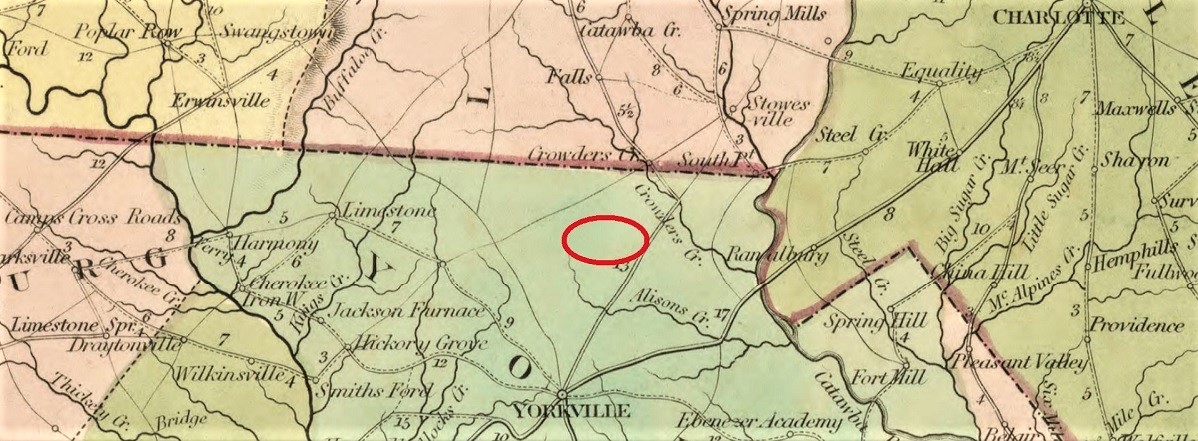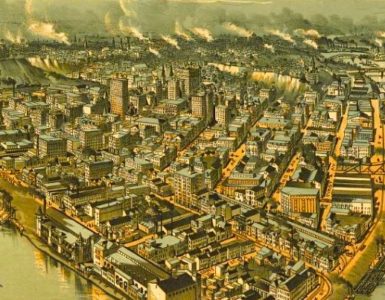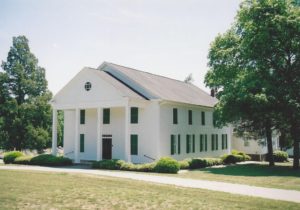 The Scots-Irish traveled down the Shenandoah Valley from Pennsylvania establishing settlements along the way and continued to distribute themselves into North Carolina and into South Carolina. They were Presbyterians and along with farms and businesses, churches were organized. Bethel Church was organized in 1764 by William Richardson who was pastor of the Waxhaw Church. When it came time to select a site for the church building a committee was selected consisting of Andrew Flynn, Col. Samuel Watson, and Mr. Baird. The three met near a spring to consider their task. They realized they were standing at a spot roughly equidistant from each of their homes and at the center of the twenty square-mile area where the church members were distributed. On that site was constructed the first of what would number four successive church buildings.
The Scots-Irish traveled down the Shenandoah Valley from Pennsylvania establishing settlements along the way and continued to distribute themselves into North Carolina and into South Carolina. They were Presbyterians and along with farms and businesses, churches were organized. Bethel Church was organized in 1764 by William Richardson who was pastor of the Waxhaw Church. When it came time to select a site for the church building a committee was selected consisting of Andrew Flynn, Col. Samuel Watson, and Mr. Baird. The three met near a spring to consider their task. They realized they were standing at a spot roughly equidistant from each of their homes and at the center of the twenty square-mile area where the church members were distributed. On that site was constructed the first of what would number four successive church buildings.
As with many rural churches, the supply of ministers for pulpits was stretched to the limit because too few qualified men were available for the churches and there was not enough money to pay their salaries. For the first six years after Bethel was organized, the pulpit was officially vacant, but it is likely that William Richardson continued to supply Bethel along with other ministers and licentiates as needed.
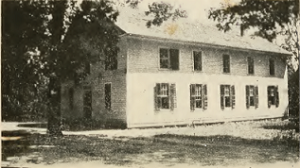 Bethel Church was able to call Hezekiah Balch for its first minster in 1770. Balch was born in Maryland and educated in Princeton College. He had served as a licentiate under the oversight of the Presbytery of New Castle and was then ordained by Hanover Presbytery in 1769. In May 1770, Balch, Hugh McAden, Henry Patillo, James Creswell, Joseph Alexander, and Hezekiah James Balch (a first cousin of Hezekiah Balch) successfully petitioned the Synod of New York and Philadelphia to form Orange Presbytery from a portion of Hanover Presbytery. Hezekiah Balch continued at Bethel until 1776 when difficulties brought upon South Carolina by the American Revolution combined with his desire to minister in eastern Tennessee led to his decision to resign. A bonus of his six-year ministry was courting and marrying Miss Hannah Lewis. While in Tennessee, Balch was involved in controversy concerning his doctrinal views that were clearly influenced by the New England Theology, particularly the doctrines taught by Samuel Hopkins. Balch’s influence contributed to make eastern Tennessee a New School stronghold in later years. After a controversial life and ministry, he died in April 1810.
Bethel Church was able to call Hezekiah Balch for its first minster in 1770. Balch was born in Maryland and educated in Princeton College. He had served as a licentiate under the oversight of the Presbytery of New Castle and was then ordained by Hanover Presbytery in 1769. In May 1770, Balch, Hugh McAden, Henry Patillo, James Creswell, Joseph Alexander, and Hezekiah James Balch (a first cousin of Hezekiah Balch) successfully petitioned the Synod of New York and Philadelphia to form Orange Presbytery from a portion of Hanover Presbytery. Hezekiah Balch continued at Bethel until 1776 when difficulties brought upon South Carolina by the American Revolution combined with his desire to minister in eastern Tennessee led to his decision to resign. A bonus of his six-year ministry was courting and marrying Miss Hannah Lewis. While in Tennessee, Balch was involved in controversy concerning his doctrinal views that were clearly influenced by the New England Theology, particularly the doctrines taught by Samuel Hopkins. Balch’s influence contributed to make eastern Tennessee a New School stronghold in later years. After a controversial life and ministry, he died in April 1810.
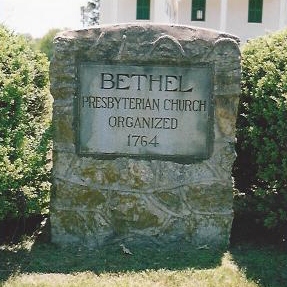 During the period 1776-1782, Bethel Church was supplied occasionally by at least three preachers one of which was Licentiate Francis Cummins. He was born in Pennsylvania to Irish immigrant parents. His education began in Clio Academy in Iredell County, North Carolina, and then he attended a classical school named Liberty Hall that met in the former Queen’s Museum building in Charlotte. Dr. James Hall in Iredell County had trained several divinity students, so Cummins turned to him for theological instruction. Cummins went on to be the second pastor of Bethel, serving 1782-1789. When South Carolina Presbytery was set-off from Orange Presbytery in 1784, Pastor Cummins was one of its six original ministers. He resigned to move to Georgia and continued in local church ministry until his death in 1828.
During the period 1776-1782, Bethel Church was supplied occasionally by at least three preachers one of which was Licentiate Francis Cummins. He was born in Pennsylvania to Irish immigrant parents. His education began in Clio Academy in Iredell County, North Carolina, and then he attended a classical school named Liberty Hall that met in the former Queen’s Museum building in Charlotte. Dr. James Hall in Iredell County had trained several divinity students, so Cummins turned to him for theological instruction. Cummins went on to be the second pastor of Bethel, serving 1782-1789. When South Carolina Presbytery was set-off from Orange Presbytery in 1784, Pastor Cummins was one of its six original ministers. He resigned to move to Georgia and continued in local church ministry until his death in 1828.
Bethel was supplied by a variety of ministers until 1811 when James S. Adams began his twenty-nine-year tenure supplying the pulpit. Though he was technically a supply minister, he is considered the third of Bethel’s pastors. He had been preaching for the Congregational Church in Dorchester, South Carolina, for six years and was a member of the Association of Congregational Ministers. Adams was a son of Bethel Church born about four miles northeast of the church property. He, as had Francis Cummins, studied theology with James Hall. R. A. Webb commented on the Lord’s Supper services at Bethel during Adams’ ministry that it “was not uncommon during this period, on sacramental occasions, for many families to leave their homes, come in their wagons…and remain until Monday….Three services were held each day….All was quiet and orderly. No extra means were used to create excitement.” Pastor Adams had a long and fruitful ministry in Bethel Church which ended in the early part of 1840 when he resigned because of declining health. Rev. James S. Adams died on August 18, 1845. “In the midst of his household, and seated in his chair, without a struggle, he ceased to breathe” (Webb).
The fourth pastor, Samuel L. Watson, commenced his long call to Bethel when he was installed April 25, 1840. He had most recently shepherded the Steel Creek Church near Charlotte.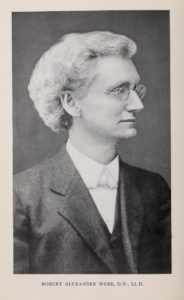 For his education, Watson attended the academy of Rev. J. M. Wilson near Rocky River Church in Cabarrus County, North Carolina. He went to South Carolina College graduating in 1820 and then on to Princeton Seminary in New Jersey for his divinity education. Licensure was granted by a presbytery in Alabama where his gifts were tested before returning to South Carolina to be ordained an evangelist. When Watson started with the congregation its session consisted of six elders, but there were not any deacons until he taught and encouraged his flock regarding the importance of diaconal ministry. The first diaconate was elected in 1845 with a membership that included an appropriate Bible number for leadership, twelve. Pastor Watson resigned from Bethel Church on September 17, 1882, at the age of 84 after a long and fruitful pastorate. He had married Miss Nancy Hannah Neel during his Steel Creek ministry and they had eight children together, three of whom died in infancy. He was buried in the Bethel Church cemetery near the grave of his uncle and predecessor in Bethel’s pulpit, Pastor James S. Adams.
For his education, Watson attended the academy of Rev. J. M. Wilson near Rocky River Church in Cabarrus County, North Carolina. He went to South Carolina College graduating in 1820 and then on to Princeton Seminary in New Jersey for his divinity education. Licensure was granted by a presbytery in Alabama where his gifts were tested before returning to South Carolina to be ordained an evangelist. When Watson started with the congregation its session consisted of six elders, but there were not any deacons until he taught and encouraged his flock regarding the importance of diaconal ministry. The first diaconate was elected in 1845 with a membership that included an appropriate Bible number for leadership, twelve. Pastor Watson resigned from Bethel Church on September 17, 1882, at the age of 84 after a long and fruitful pastorate. He had married Miss Nancy Hannah Neel during his Steel Creek ministry and they had eight children together, three of whom died in infancy. He was buried in the Bethel Church cemetery near the grave of his uncle and predecessor in Bethel’s pulpit, Pastor James S. Adams.
Robert Alexander Webb was the fifth pastor of Bethel Church. He was born at College Hill near Oxford, Mississippi, September 20, 1856. His college studies were at South Western Presbyterian University located at the time in Clarksville, Tennessee. Called to the ministry, he prepared for pastoral work by studying theology in Columbia Theological Seminary. While meeting for classes and delving into the intricacies of doctrine in seminary, he made the acquaintance of Professor John L. Girardeau’s daughter, Sarah. Seminary campus marriages were common and the wedding of Robert and Sarah was added to the list of unions in 1880. However, Rev. Webb remarried in 1888 following Sarah’s death. The cause of her passing may have been complications resulting from delivery of a child. R. A. Webb was ordained and installed in the Bethel Presbyterian Church in 1882. After six years, he left Bethel to work at Davidson College for about a year, then he was the pastor of Second Presbyterian Church in Charleston, 1889-1892. He left pastoral ministry to return to his alma mater to teach theology in the Divinity School at Southwestern Presbyterian University for the next sixteen years. His final call required him to move to Kentucky in 1909 to become a professor in Louisville Presbyterian Theological Seminary where he continued until his death on May 20, 1919.
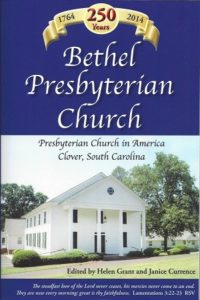
This post on Presbyterians of the Past summarizes the history of Bethel Church to about the end of the First World War, so to continue the narrative for the next century readers are encouraged to read the 250th anniversary book titled, Bethel Presbyterian Church: Presbyterian Church in America Clover, South Carolina, which was edited by Helen Grant and Janice Currence and may still be available for purchase from the church office. The book includes the text of R.A. Webb’s brief history. Bethel’s facilities have expanded and the columned sanctuary on the book cover continues in its lovely original setting. The large cemetery with its stone wall shows the long history of the congregation with graves dating to the eighteenth century. The black-and-white photograph earlier in this article presents the sanctuary before a portico was added. The columns have decorative appeal and provide worshippers entering the sanctuary with a sense of the greatness of God.
Barry Waugh
Notes—The map in the header is from the Library of Congress collection and is dated 1839; the location of Bethel Church with the red ellipse is approximate. Why did Rev. Adams serve as a supply for so many years and not as a regularly installed minister? It may be that since he went to Bethel as a pastor from the Association of Congregational Ministers, the presbytery allowed him to supply because of the shortage of ministers and his supply status was under a watchful eye. Professor George Howe of Columbia Seminary wrote about the ministerial shortage problem in South Carolina twenty-five years after Adams began his ministry at Bethel. If interested, see the author of this site’s article, “The Ministerial Shortage Problem in Presbyterian History & George Howe’s Appeal for More Ministers,” and the transcription of Howe’s sermon, “An Appeal to the Young Men of the Presbyterian Church by George Howe (1802-1883),” in The Confessional Presbyterian 4, on pages 43-71. The sources used include: the information on Liberty Hall in Charlotte is from NCPedia; R. A. Webb, History of the Presbyterian Church of Bethel Compiled by Rev. R. A. Webb, Fifth Pastor, Originally Issued in 1887 by The Ladies Aid Society, Revised to April 1, 1938; and R. H. Stone’s, A History of Orange Presbytery 1770-1970, Greensboro, 1970. The color photographs were taken by this site’s author in 2006. The portrait of R. A. Webb was provided by Wayne Sparkman of the PCA Historical Center in St. Louis, Missouri.


